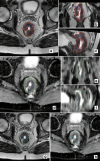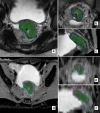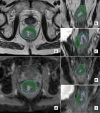Manual and semi-automated delineation of locally advanced rectal cancer subvolumes with diffusion-weighted MRI
- PMID: 32877210
- PMCID: PMC7548370
- DOI: 10.1259/bjr.20200543
Manual and semi-automated delineation of locally advanced rectal cancer subvolumes with diffusion-weighted MRI
Abstract
Objectives: To evaluate interobserver agreement for T2 weighted (T2W) and diffusion-weighted MRI (DW-MRI) contours of locally advanced rectal cancer (LARC); and to evaluate manual and semi-automated delineations of restricted diffusion tumour subvolumes.
Methods: 20 cases of LARC were reviewed by 2 radiation oncologists and 2 radiologists. Contours of gross tumour volume (GTV) on T2W, DW-MRI and co-registered T2W/DW-MRI were independently delineated and compared using Dice Similarity Coefficient (DSC), mean distance to agreement (MDA) and other metrics of interobserver agreement. Restricted diffusion subvolumes within GTVs were manually delineated and compared to semi-automatically generated contours corresponding to intratumoral apparent diffusion coefficient (ADC) centile values.
Results: Observers were able to delineate subvolumes of restricted diffusion with moderate agreement (DSC 0.666, MDA 1.92 mm). Semi-automated segmentation based on the 40th centile intratumoral ADC value demonstrated moderate average agreement with consensus delineations (DSC 0.581, MDA 2.44 mm), with errors noted in image registration and luminal variation between acquisitions. A small validation set of four cases with optimised planning MRI demonstrated improvement (DSC 0.669, MDA 1.91 mm).
Conclusion: Contours based on co-registered T2W and DW-MRI could be used for delineation of biologically relevant tumour subvolumes. Semi-automated delineation based on patient-specific intratumoral ADC thresholds may standardise subvolume delineation if registration between acquisitions is sufficiently accurate.
Advances in knowledge: This is the first study to evaluate the feasibility of semi-automated diffusion-based subvolume delineation in LARC. This approach could be applied to dose escalation or 'dose painting' protocols to improve delineation reproducibility.
Figures









References
-
- Burbach JPM, den Harder AM, Intven M, van Vulpen M, Verkooijen HM, Reerink O. Impact of radiotherapy boost on pathological complete response in patients with locally advanced rectal cancer: a systematic review and meta-analysis. Radiother Oncol 2014; 113: 1–9. doi: 10.1016/j.radonc.2014.08.035 - DOI - PubMed
-
- Hearn N, Atwell D, Cahill K, Elks J, Vignarajah D, Lagopoulos J, et al. . Neoadjuvant radiotherapy dose escalation in locally advanced rectal cancer: a systematic review and meta-analysis of modern treatment approaches and outcomes. Clin Oncol 2020;12 Jul 2020. doi: 10.1016/j.clon.2020.06.008 - DOI - PubMed
-
- Valentini V, Gambacorta MA, Cellini F, Aristei C, Coco C, Barbaro B, et al. . The INTERACT Trial: Long-term results of a randomised trial on preoperative capecitabine-based radiochemotherapy intensified by concomitant boost or oxaliplatin, for cT2 (distal)-cT3 rectal cancer. Radiother Oncol 2019; 134: 110–8. doi: 10.1016/j.radonc.2018.11.023 - DOI - PubMed

